Welcome to blokeh's block blog: a (very irregular) chronicle of my adventures at Eva Valley in Australia's Top End (and whatever else springs to mind). This page contains the most recent posts as well as links below to older ones. You're welcome to comment if you wish.
A little Christmas drama
Late in the afternoon of a very hot Christmas day, I escaped with my camera into the relative cool of the rainforest.
I wanted to check on a nesting pair of shining flycatchers I'd spotted a few weeks earlier.
These pretty little birds are common throughout the block. They are nearly always in pairs: the male a gleaming black/blue; the female an equally pretty white, brown and black. They breed in very neatly constructed and well-camouflaged little nests built directly over water.
This was the scene when I first encountered the flycatchers:

 The nest was set up over a channel running between two parts of the main billabong. It was deep in the shadows under a canopy of vines and palm fronds. Even from nearby, it was hard to spot - which presumably was the whole point.
The nest was set up over a channel running between two parts of the main billabong. It was deep in the shadows under a canopy of vines and palm fronds. Even from nearby, it was hard to spot - which presumably was the whole point.
(I'd actually spotted the nest when I was hoping to get another look at a golden tree snake I'd seen in the same area a few days earlier.
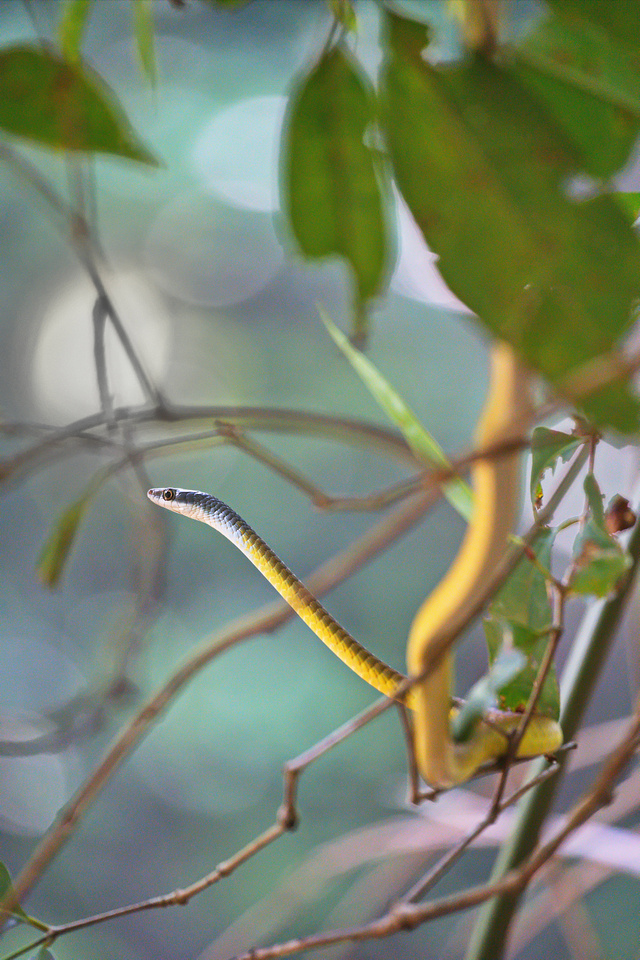

On reflection, it's quite possible the snake was sizing up the nest.)
The male and female flycatchers were taking turns bringing little spiders and insects back to the nest.
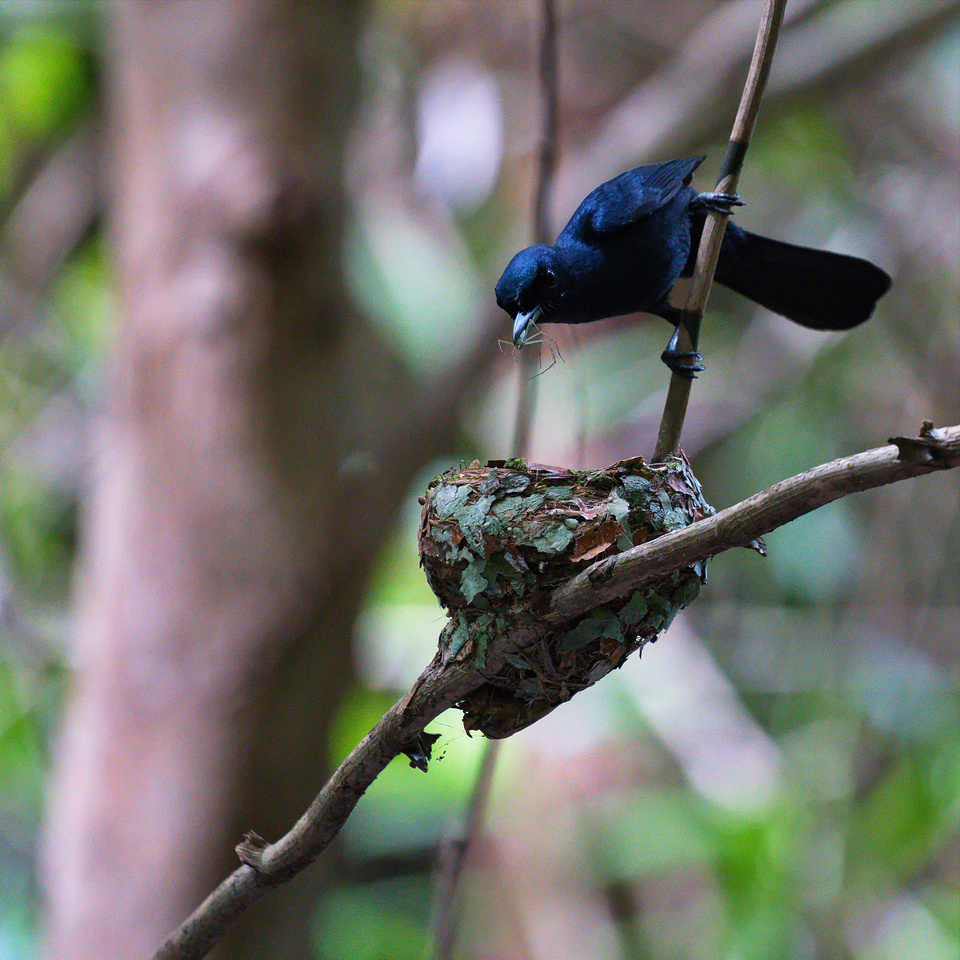

Every now and again a hungry chick's head would pop into view.

 ***
***
On Christmas Day, I could see no activity at the nest, so I wandered downstream along the edge of the billabong looking for other potential pics.
I'd walked maybe 10 metres when I got swooped by a male flycatcher. It was not a frenetic salvo (nothing like the magpie terrors of my childhood) - more a polite warning - so I backed off a little, sat on a rotting log and tried to work out what was going on.
Soon I spotted what I initially thought was the female of the pair. She was fluttering up and down from a perch on tree roots another 20 metres or so further along the bank.
I was able to get a much closer look using the long lens on my camera. An adult female flycatcher was there, but all the fluttering was being done by a fledgling.
It was clearly very early days in the chick's flying career. It would buzz its little wings furiously and every now and again get airborne for a few seconds before plummeting back into the tangle of roots. Mum and dad were hovering nearby.
If you've ever seen someone trying to operate a drone for the first time, you will be able to visualise what happened next.
On one of her leaps of faith, something caused the chick to tilt in the direction of the billlabong. All of a sudden, her upwards momentum turned sideways and she careered about 15 metres towards the deepest part of the pool - crash landing into the water before clambering up onto a tree root just above the surface.
This was the scene soon afterwards:
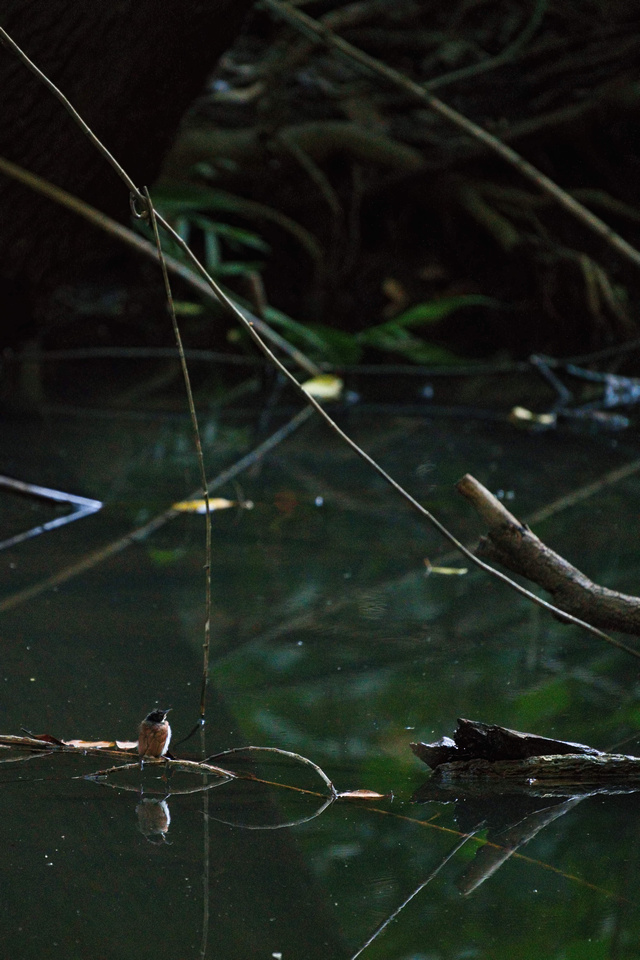

That part of the billabong is teeming with potential threats to a bite-sized flycatcher. Apart from the airborne perils (spangled drongos, herons, darters, sea eagles) there are freshwater crocs, monitors, large turtles and even juvenile barramundi that could have gobbled her up in an instant.
Mum was close by and clearly concerned.
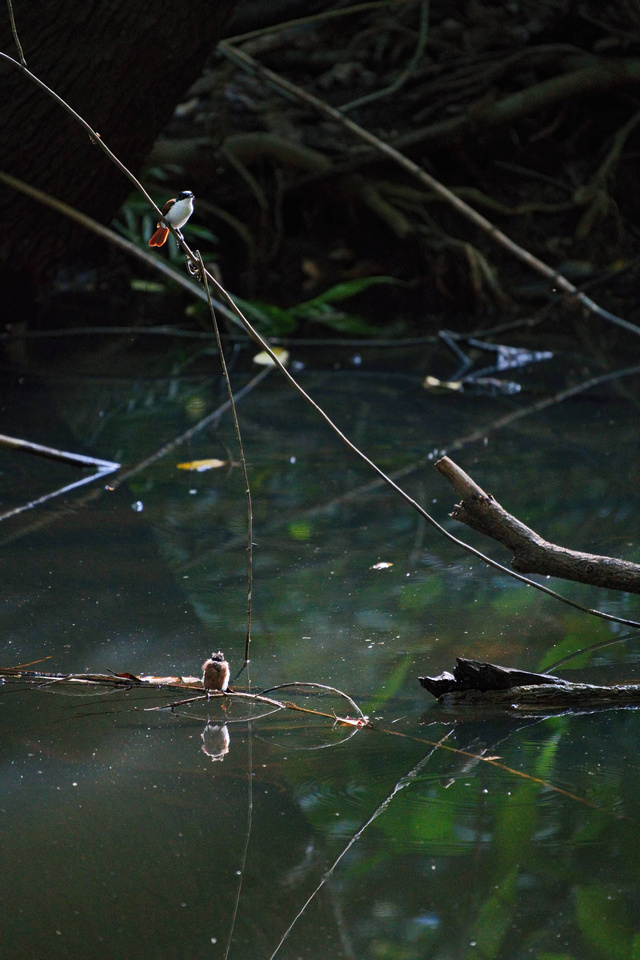

She was coming and going regularly; each time perching above the chick before flying down and hovering much closer and then darting away.
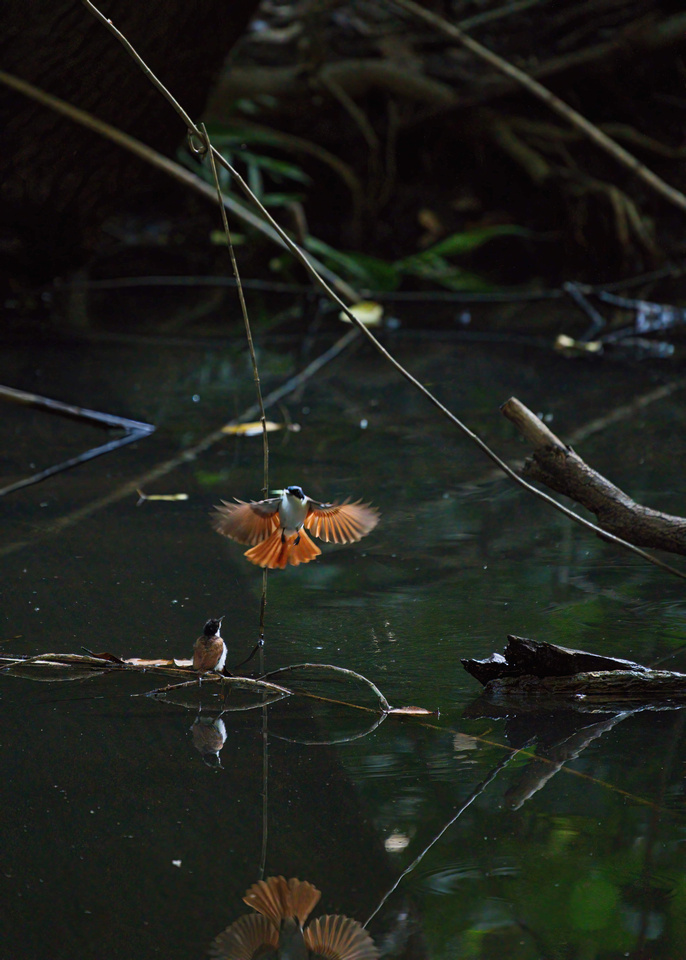

I thought at the time that she was trying to demonstrate what the chick needed to do.
But the little ball of feathers just stayed there - seemingly very calm and completely oblivious to the danger. (In the time I was watching, I saw several ominous bubble trails circling around her, as well as the occasional bow wave of something substantial swimming just below the surface.)
After about an hour, mum was doing another series of her hovering routines when the chick started flapping its little wings every now and then.
Finally - and I'm sure not completely intentionally - she was airborne and off to a safe perch on the far bank (mum still watching on intently).


I assumed that the chick had finally got mum's message, but (as so often happens with photography) when I looked closely at the photos, they told a different - and much more straightforward - story.
I realised that each time the mother had been buzzing the chick, she'd had a freshly caught insect in her beak.
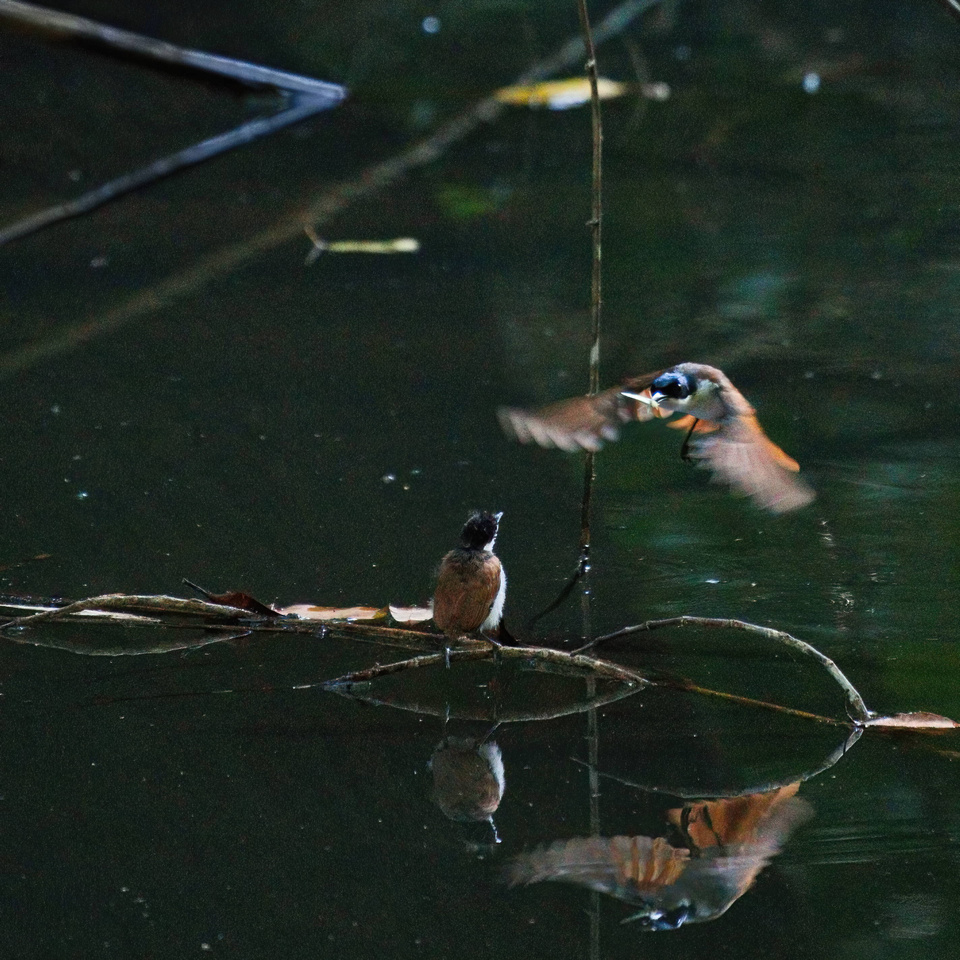
 And the chick was responding in pretty much the same way as a few weeks earlier in the nest.
And the chick was responding in pretty much the same way as a few weeks earlier in the nest.
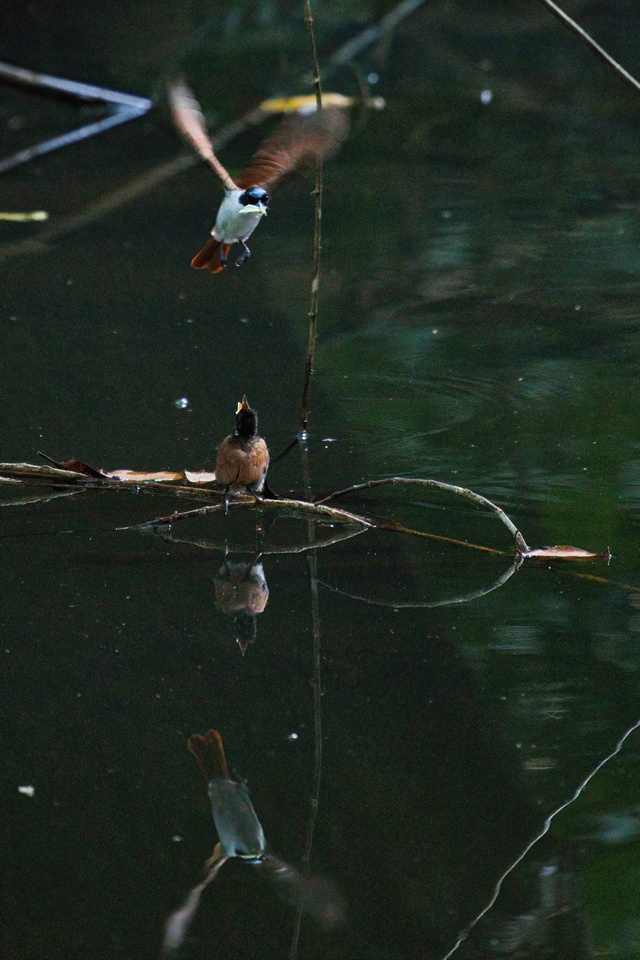

Only this time, mum had no intention of feeding her baby while it was marooned in the middle of a death trap - she was making it fly for its life.
Mr Simon
Mr Simon was my English teacher for a few years in high school.
I did not like him and nor did many of my classmates. He was a single (I think) man of about forty-five with a neatly cropped moustache and a US Marines crew cut (though any military allusions ended there). He dressed very formally and wore his pants improbably high. He had a superior, pompous, countenance and a short fuse. If he was in a shitty mood he didn't make any effort to hide it - even if we'd had nothing to do with whatever was bothering him (though generally we had).
He was, however, someone I somehow respected. I never looked forward to his classes; but often I enjoyed them. Mr Simon took his job seriously; he didn't care whether we liked him, but he did care whether we were learning anything.
And he was pretty good at reading people.
He had me nailed.
I was one of the stronger students in the class. When I did something well, he was generous with praise; but when I did not measure up, he could be vicious.
There was one class when he'd asked us the day before to think overnight about little tricks for remembering how to spell difficult words.
As he went around the class, it was clear that some of the kids had come up with really great ideas - some that I still remember and use 40 years later ('independence is 'e'-zy' (Andrew); 'manoeuvre a canoe' (Derek)).
I had nothing - in fact, I'm pretty sure I'd dozed through the critical juncture of the previous class. When he got to me, I said something like 'I just look at the word and see if it looks okay' (which was, and is, true; but is not a lot of use to anyone else).
He exploded.
(I interpose here - in case Mr Simon is alive and marking this - that I have since come up with a quite a good way of differentiating 'discreet' and 'discrete': in 'discrete' the 'e's are separate.)
There was another explosion when we'd all been asked the day before to bring in a book we were to read and review. Once again, I'd missed that bit, but a mate had come to the rescue by slinging me a second book he had in his bag. When Mr Simon got to me, I confidently produced my 'selection': 'Get Smart: Once Again', a novelisation of the immortal TV show ('there was a TV show?' [a gag for the true aficionados]).
The excoriation that followed - which involved him denigrating my selection by comparing it to the book chosen by another student, Mil ('To Kill a Mockingbird' or something similarly lightweight) - was completely justified; save that it was Mil who'd loaned me the Get Smart book. I can still picture him smiling at me - half apologetically and half delightedly - from up the row of desks.
Mr Simon liked to write lengthy comments on our homework. He once wrote that an essay I'd written (about friendship) had started well, only to be be completely spoilt by one paragraph (where - perhaps for the sake of the word count - I'd riffed about friendship between countries, a notion Mr Simon seemed to find offensive). He concluded his tirade with this: "You must eschew complacency! (Two words for your dictionary.)"
As soon as I'd read this - and somehow completely oblivious to the fact he was making two suggestions - I walked straight up to his desk and asked him what 'eschew' and 'complacency' meant. (He reacted with the mixed disgust and triumph of a person who has successfully squashed a fly.)
And he was right.
I really must.
Buying the block
In October 2021, I started six months long service leave. I'd been working more than thirty years and had never had such a long break.
Apart from taking lots of photos and visiting my mum and dad in Queensland, I had no firm plans. Mainly, I just wanted to stop and see what it felt like.
Stopping started slowly.
About a fortnight in, I checked in at a very nice airbnb place not far from mum and dad's. Having already bought the sort of groceries I'd buy at home, I spent an hour or so unpacking all the gear and establishing all the connections that I'd packed and disconnected a day earlier in Darwin.
And soon enough I'd settled into the routines that shaped me.
One of those routines was cycling every few hours through a dozen or so websites - making sure I wasn't missing anything. (I very rarely was.)
The websites included an online real estate site. I'd been visiting it on and off for years in the search for the perfect bush block. Something ticking all the boxes - unspoilt, permanent swimmable water, close-ish to Darwin and affordable - had (somehow!) proven elusive.
About a year earlier, we had narrowly missed out on one contender - which was stunning but lacked permanent water. It had been on the market for more than a year and we'd inspected it many times. We umm'd and ahh'd for ages about making an offer - doing our best to come up with new reasons not to buy it. And when, finally, we bit the bullet, someone else also did (and offered slightly more).
Nothing else had come close, so I was a bit surprised when my idle online scrolling turned up this ad:
"Eighty Eight Acres - Pristine* Rain-Forest - Well Located - Permanent Water - Orchard
Thirty five hectares of very old rain forest, close to Litchfield National Park... The bitumen stops outside our main entrance. All but the home paddock is covered in tropical rain forest and other native* trees. The tropical rain forest pre-dates the eucalypts, and is a remnant of an era when the Top End was mainly wetlands. The property is one of the few remaining examples of tropical rain forest in private hands. A tributary of the Little Finnis River runs through the valley, and there is a deep spring fed billabong that has never run dry. The rain forest supports native birds, possums, wallabies, lizards and the occasional fresh* water croc. There is a mango orchard of around sixty trees, which provides a small income. The mangoes are allowed to ripen on the trees, and are sold dehydrated or frozen. Other fruit trees have been planted close to the bush shack built near to the main road. The shack has a bathroom, kitchen, and a bedroom with an air conditioner..."
[* the asterisks denote parts of the ad that could perhaps have been expressed differently.]
The photos with the ad seemed to back up the description.
After a few inspections we offered the asking price. It turned out this was only half the task; the owner only accepted once she was sure we were the right people.
And so, about 10 weeks into my leave, we became the owners of 730 Miles Road, Eva Valley.
Here's what it looks like from the sky. (Our place is to the right of the purple line and I've included the imaginative names we've come up with for the four corners):


The shack we now call our home away from home is right in the middle of the cleared area near corner 1. The other visible structures are a mixture of sheds and never-finished building projects. The mango trees are also visible in that area.
The place immediately to the West belongs to Trevor. Parts of it are very similar to ours, but he's got many more mango trees (and so, less bush). Trevor's a fascinating bloke, worthy of a separate blog post (or several). His claims to fame include having been on Grand Designs Australia (for a project at Lake Bennett that didn't end well). He's also the local snake catcher. He and his dogs regularly detain feral pigs, which he feeds to his substantial collection of 'pet' saltwater and freshwater crocodiles. (The main croc pens are beside the two white dots very close to the boundary with our place.)
To our north is a large mango farm. Its south western and south eastern extremities correspond with our corners 1 and 2. It is bisected by a very large dammed area. Miles Road runs across the causeway which forms the dam. Although it is not a natural water feature, it very much resembles a Top End wetland. It hold water most of the year and is often teeming with birds.
The purchase of the block was followed by another, even bigger, development.
In our first month or so at Eva Valley we came to realise the scale of the task we'd taken on.
My dream had originally been for a weekend retreat; but it was pretty clear that more than weekends would be needed if we were to give the block the attention it needed.
All of sudden, we had an 80 acre backyard. Even though most of it was uncleared, there was still the equivalent of many (very bumpy) football fields to mow every few weeks (in the Wet at least). And there was the 'fleet' of honest, but tired, farm machinery (quad bike, ride-on mowers, brush cutters) to repair and maintain.
And then there were the weeds. Although we knew there were problems, we had no real idea of the extent. And the more we explored the block, the more we found. (I've done a separate post about snake weed, the main culprit.)
We could possibly have paid someone to do the necessary work, but I didn't want that. The more time I was spending there, the more I loved the place and the more I came to like the feeling that it was our responsibility. (That feeling is still a huge motivator 18 months down the track.)
So I quit my day job.
It was a very good, very well-paid, job (best I'd ever had); but I was close to my 'best before' date - in fact, when I went in to the office and logged on to write my resignation notice, I was reminded that I'd actually done a draft resignation letter before I decided to take my long service leave.
Had we known - back in November 2021 - everything we came to learn about the block, I think there's a good chance we'd have talked ourselves out of it.
But - in a marked departure from previous form - we'd thrown caution to the wind.
I'm so glad we did. I have no idea of how this adventure will end; but for the moment, I am happy in a life that has been turned upside-down.
The Saltie
(updated April 2023 - see bottom)
My friend Max came to visit in May 2022.
Within two hours of my picking him up from the airport, we had set off on a tour of the bush parts of the block.
Our route started at a gloomy shed on the bank of the deepest permanent pool in the rainforest. The shed houses a pump which we use to draw water up to a tank at the shack (about 300 metres away). The former owners called the shed 'the pump house' and the pool 'the billabong' - both names have stuck.
Immediately, Max and I were greeted with the smell of something (very) dead. We soon spotted the source: a feral pig carcass snagged in a partly submerged tree branch about 20 metres from the pump house.
Unfortunately the pig was upstream of the pump intake, so there was the risk it would foul the water supply.
So the block tour was postponed; and instead, Max and I each rigged up contraptions to get the pig out of the water. His worked better, and we* were able to drag the carcass up into the rainforest, where we then spent another half an hour or so burying it. (*I use 'we' loosely here - I was nursing a crook shoulder from overdoing it a few days earlier, so I grudgingly allowed Max to do most of the grunt work.)
Although I'd become accustomed to the block's habit of laughing in the face of my best-laid plans, it was a perfect introduction for Max, who in six hours had gone from sitting in the bland comfort of the departure lounge at Brisbane airport to being covered in mud and smelling of dead pig.
When we'd first spotted the carcass, it had appeared quite small. I thought it was maybe a piglet that had drowned. But once we'd landed it, it turned out to be quite big; it was clearly a young adult, albeit one that had parted ways with much of its body.
There was one explanation that was more likely than any other (we'd been told before buying the block that saltwater crocodiles were a possibility); however, in the absence of a sighting, I think I allowed myself to think that maybe a large freshwater croc could have been responsible.
Sonja and I had seen a couple of freshies in the previous months. One was probably big enough to take on a pig, but it seemed to hang out at the other end of the block. The other, which I had spotted right beside the pump house, would definitely have have been a suspect, had it not been only 30cm long.
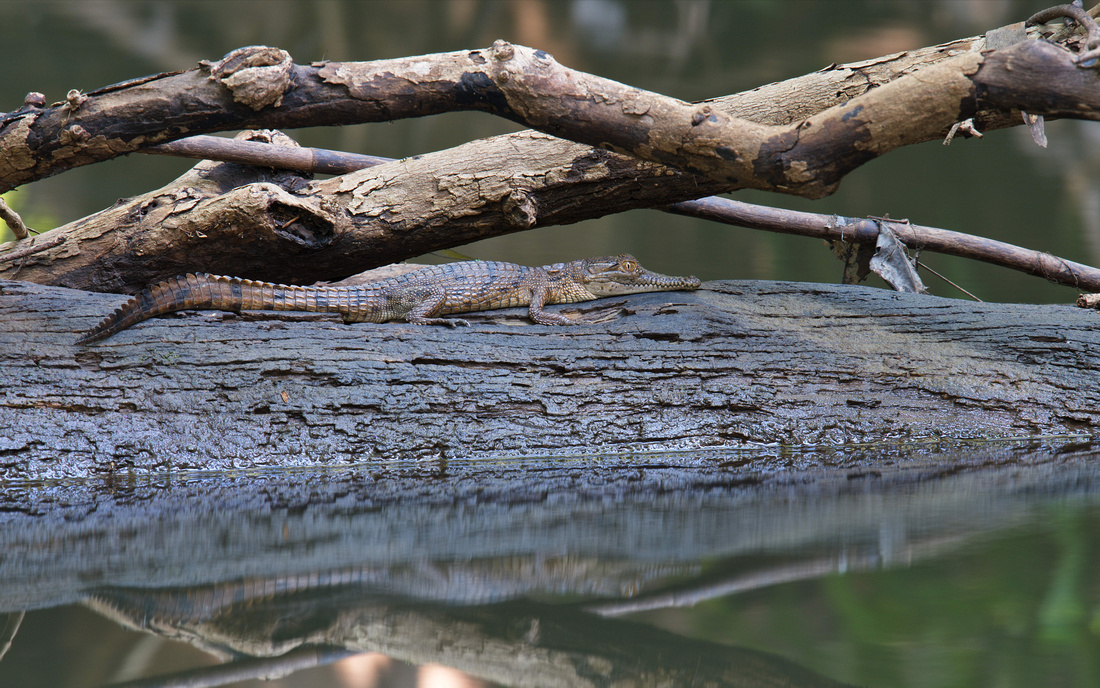

A few months later, I was working in the rainforest, about 100 metres upstream from the pump house.
I was well into digging a large hole in the loamy ground around a shallow spring that feeds into the billabong. The aim was to expand the spring into a plunge pool that would be safe and deep enough to cool off in on hot days. The idea seemed to be working - I'd already created a bathtub-sized hole that quickly filled up with nice clear water.
And then the block started laughing again.
Another dead pig turned up in the billabong - this one up against the bank right at the point where water from the 'bathtub spring' trickled into the main pool.
Max-less, I quickly realised what was in store for me; however, it was late afternoon, and I was tired, and the pig was quite a long way from the pump intake, and it didn't seem too smelly just yet... (or, just perhaps, I was looking for any excuse to put off the inevitable).
I went back the next morning (armed with Max's bespoke pig-hooker) only to discover that the carcass was now wedged into the submerged roots of a large clump of pandanus trees, well out of reach on the far side of the billabong. My disappointment - which, in truth, was half-hearted - gave way to a strong sense that whatever had moved the pig was probably nearby.
Xavier (our elderly and not especially brave pooch) and I went back for another look later that day. We approached slowly from upstream, well back from the water's edge. I could see the pandanus clump (which was diagonally across the billabong) but not the pig.
Then I heard a swoosh and saw the back half of the saltie sliding into the pool from under the pandanus. Xav and I were maybe 20 metres away.
Although I was (sort of) expecting it, I was not ready for how massive it looked. I'd seen many crocs in my time in the NT, but never in such a confined space. And never in the backyard.
I was also struck by how quietly it entered the water and how, despite its bulk, it barely caused a ripple in the surface of the billabong.
In the following days, I returned several times with my camera. I discovered that the croc was easily spooked and that I needed to creep through the forest to get close enough for a decent look. Although I could sneak up out of sight behind the many trees and vines, a snapped twig was enough to spoil the mission.
Even when I had a good line of sight to the croc's lair, I could not see the whole animal. Usually I'd spot the tail first and then try and work out where the rest was likely to be. The croc's head was not always visible, but whenever I managed to spot it, its eye seemed to be looking straight at me.


I haven't seen it for a while, but have no reason to think it's not around.
I can only guess how big it is; but it is big (maybe 3.5 metres). And it is solid - no doubt well fed by the steady stream of wildlife that comes to drink at the billabong. It is definitely the sort of animal that could eat a person if given the chance.
Some people are appalled at the idea that we have a potential man-eater living a few hundred metres from the shack.
I see it differently.
The croc is not in an area where we would ever have considered swimming. It poses no threat to us if we stay back from the edge of the deeper pools. And there is pretty compelling evidence that it helps get rid of feral pigs.
And it's exactly where it's meant to be (or was meant to be - see below).
[PS - I'd basically finished this post months ago but had been typically slack about tidying it up and sticking it up on the blog. As it happens, this is a very good day to publish it. The photo above of the saltie is included in the artwork for the latest album by The Church, The Hypnogogue, which has been released today. (It's brilliant of course.)]
Update - April 2023
Our neighbour to the north (a mango farmer) came over in early March asking if we'd seen his dog. We hadn't. He suspected it may have been taken by a croc. Within a few days a croc trap appeared in his dam (which is actually more like a wetland and is separated from our block by a causeway). A few weeks later a 3.6 metre saltie was apparently caught (and most likely relocated to a croc farm).
I strongly suspect it was 'ours'.
Pulling a thousand a day
The bush parts of the block - about 90% of its 80 acres - are a mixture of different types of terrain. The areas near the permanent springs are classified as evergreen monsoon vineforests (which, in look and feel, are about as close as the Top End gets to the tropical rainforests of the east coast).
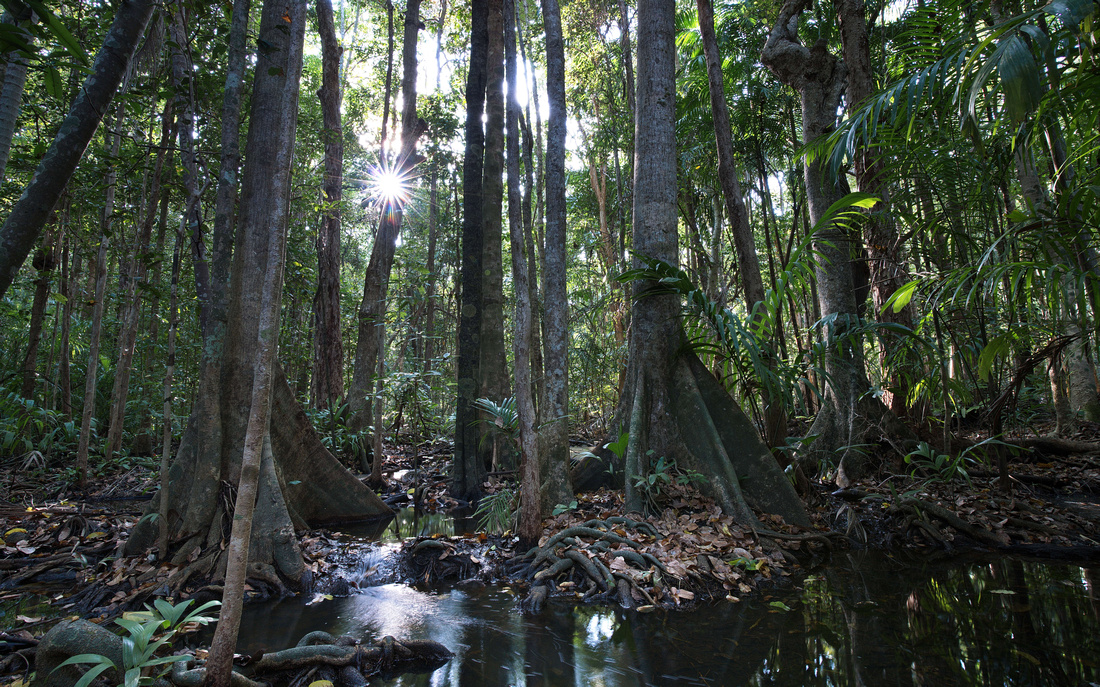
 Away from the springs, in areas that are inundated in the Wet season, but dry out completely by May or June, are dense tracts of paperbarks and pandanus.
Away from the springs, in areas that are inundated in the Wet season, but dry out completely by May or June, are dense tracts of paperbarks and pandanus.
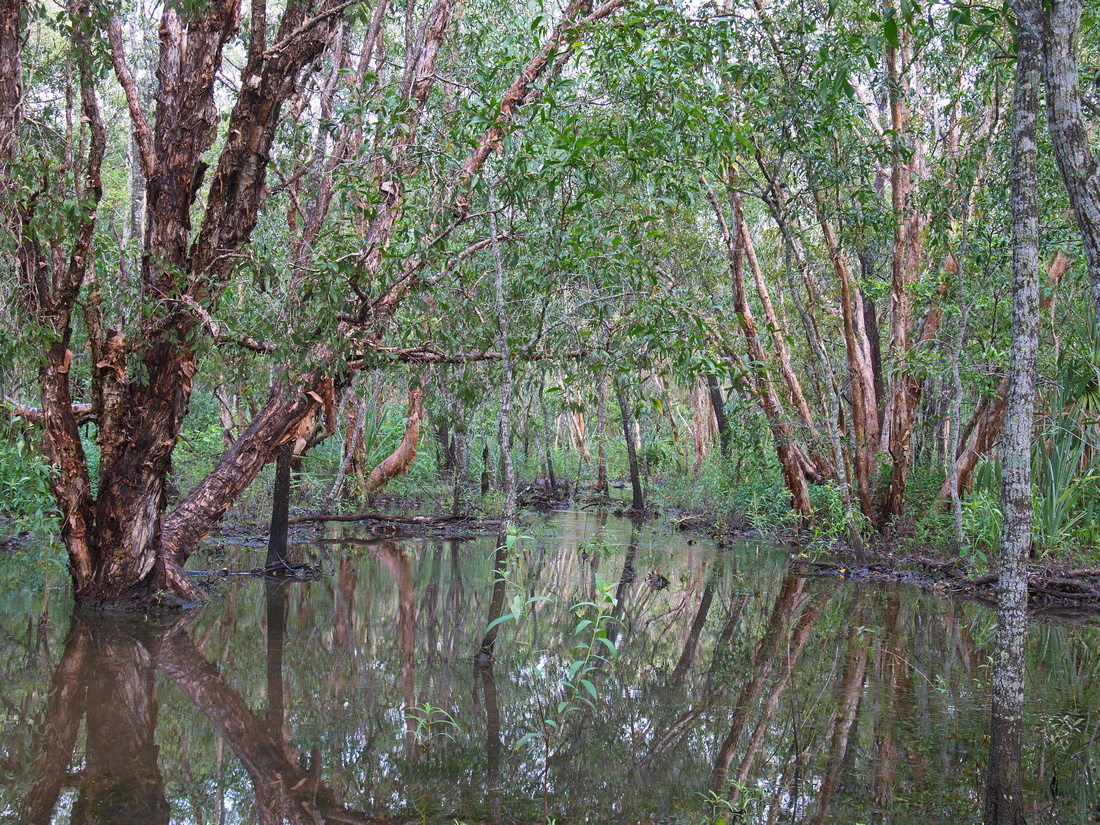

The vineforest and paperbark swamps are home to an amazing variety of birdlife. Although the composition of the orchestra changes with the seasons, it performs every day of the year, saving its best for dawn and dusk (there's a sample in the youtube video below).
Some days, the birdsong is interrupted mid-morning by a loud and distinctly unmelodious human exclamation.
It is me, yelling out in a ridiculously theatrical and drawn out fashion "OOOOOONE HUNNNNN-DRED AND EIGHT-TEEEE!!!"
It's a throwback to my university days, when one of my many (many) ways of wasting time was to watch English darts tournaments on TV - usually with a bunch of other blokes with similar devotion to their studies. We quickly learned to join in with the referee's overblown exclamations whenever someone threw three consecutive triple-twenties. Inevitably, a cry of '180!' became the standard acknowledgement of any sort of a win (whatever the context) and, generally speaking, the bar for a 'win' tended to get lower the longer the night went on.
****
This is snake weed.
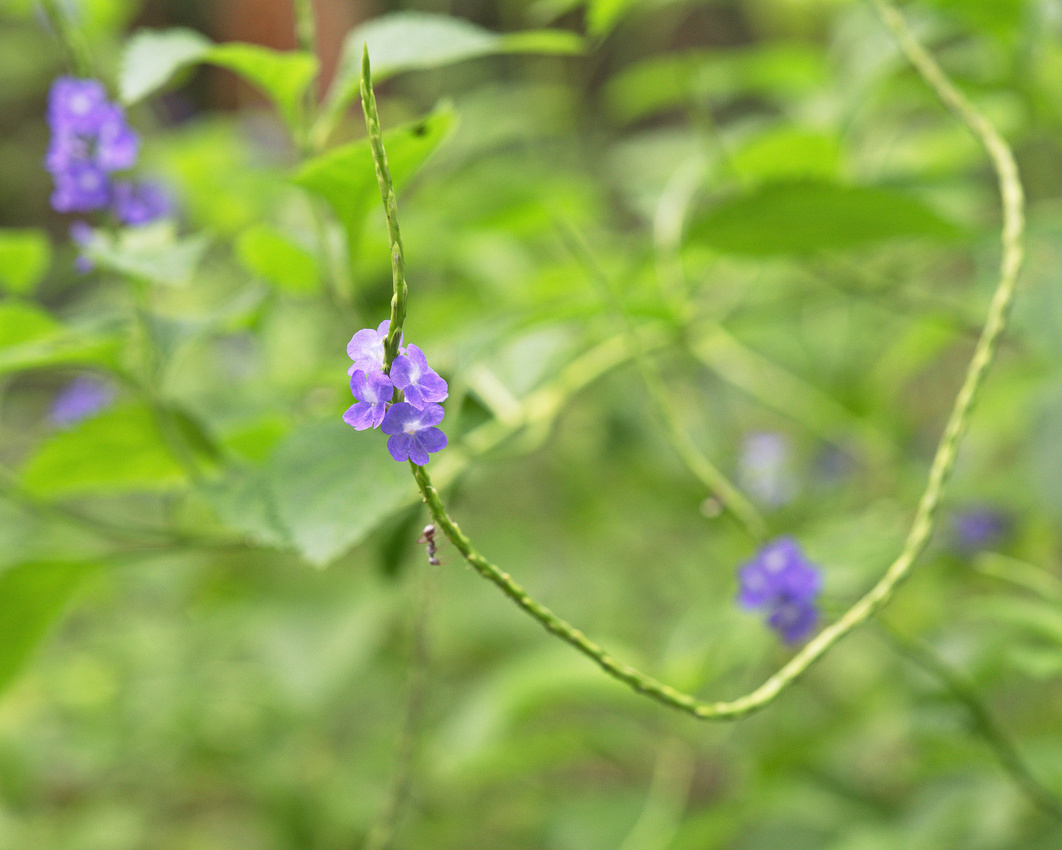

It's quite an attractive shrub and I imagine it spent its first few years after arriving in Australia (when it doubtless had a nicer name) looking decorative in gardens from northern New South Wales to far North Queensland.
Unfortunately it was also pretty good at jumping fences and now it infests rural properties right across tropical Australia, including ours.
Most is in the paperbark* swamp and around the fringes of the springs; but only the darkest, shadiest, parts of the block are completely spared. (*In an appalling irony, snake weed is a native of the tropical Americas where Australian paperbarks are a noxious weed.)
It takes over clearings and is so good at establishing itself - it produces flowers and seeds all year - that the native plants that are meant to be there cannot get a foothold.
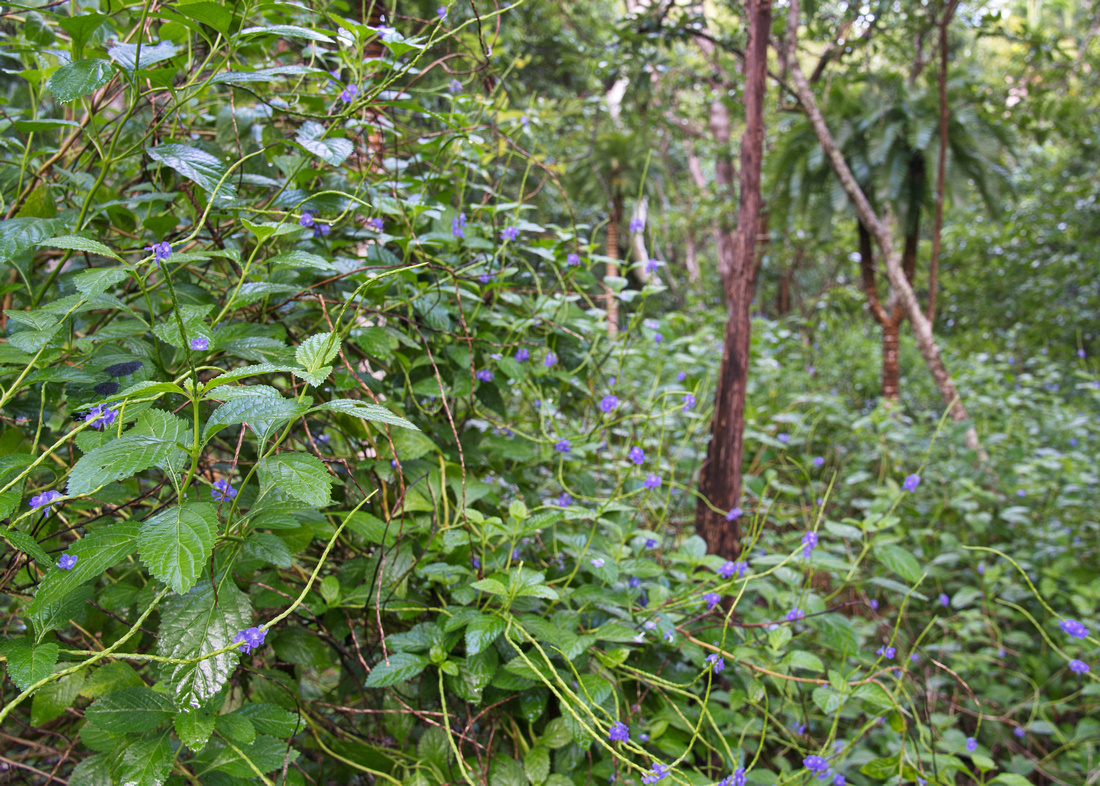
 It also provides shelter and cover and to other unwelcome visitors to the block - notably feral pigs and cats - and cane toads.
It also provides shelter and cover and to other unwelcome visitors to the block - notably feral pigs and cats - and cane toads.
It does have some redeeming features - at least when compared with many other weeds.
It is not prickly or sticky and it doesn't make you itch.
It's also quite shallow rooted - even the more established plants, which can be two metres high and at least as wide, will usually yield to a firm and sustained tug [insert crude bloke joke here].
Snake weed has been my main day job since we bought the block. When conditions permit (access can be a problem in the Wet), I try and spend at least a few hours several days a week 'pulling snakies'.
I actually really enjoy it. It's very good low-impact exercise and - apart from dehydration and the odd ant bite or wasp sting - the risks are minor. It's also pretty mindless so there's plenty of the time for the mind to wander.
The scale of the task is enormous - I'd guess that maybe half of the forested areas have been affected - but we have made some real progress in our first year.
A big motivator is that the transformation as an area is cleared is immediate and can be stunning. This time lapse should give you an idea.
The work we've done in the paperbark forest has also made that area much safer in the Wet season. This time last year, visibility was often limited to a few metres - a bit unnerving in an area where pigs are common and crocs are not out of the question. Now, there are clear lines of sight for 20 or more metres. (I will do a separate post about a close call with a herd of pigs.)
When I first got started, I set myself the lofty task of pulling a thousand snakies a day. I've only reached that mark a couple of times (usually courtesy of patches of tiny seedlings - they all count) but 400 to 500 is the usual mark.
And, every session - revelling in the unselfconscious silliness that isolation permits - I celebrate number 180 by raucously channelling the darts referees of my youth.